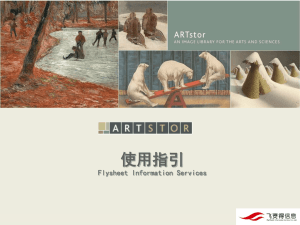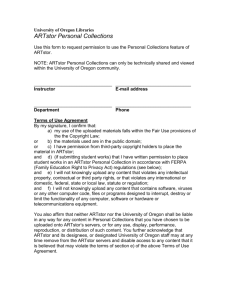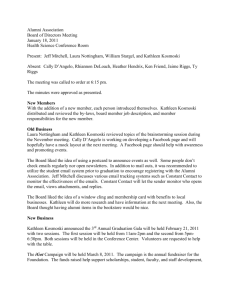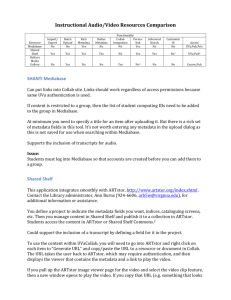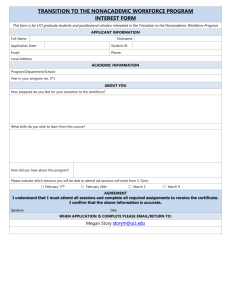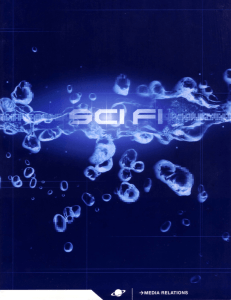UC Sliders Summer Meeting 2007
advertisement
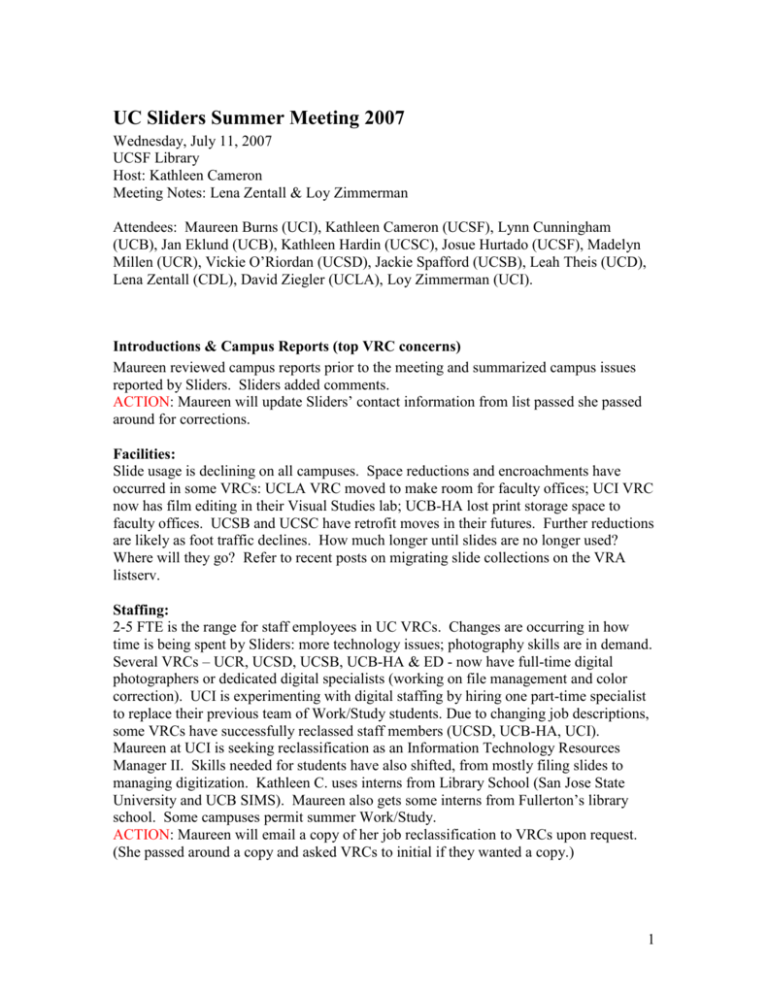
UC Sliders Summer Meeting 2007 Wednesday, July 11, 2007 UCSF Library Host: Kathleen Cameron Meeting Notes: Lena Zentall & Loy Zimmerman Attendees: Maureen Burns (UCI), Kathleen Cameron (UCSF), Lynn Cunningham (UCB), Jan Eklund (UCB), Kathleen Hardin (UCSC), Josue Hurtado (UCSF), Madelyn Millen (UCR), Vickie O’Riordan (UCSD), Jackie Spafford (UCSB), Leah Theis (UCD), Lena Zentall (CDL), David Ziegler (UCLA), Loy Zimmerman (UCI). Introductions & Campus Reports (top VRC concerns) Maureen reviewed campus reports prior to the meeting and summarized campus issues reported by Sliders. Sliders added comments. ACTION: Maureen will update Sliders’ contact information from list passed she passed around for corrections. Facilities: Slide usage is declining on all campuses. Space reductions and encroachments have occurred in some VRCs: UCLA VRC moved to make room for faculty offices; UCI VRC now has film editing in their Visual Studies lab; UCB-HA lost print storage space to faculty offices. UCSB and UCSC have retrofit moves in their futures. Further reductions are likely as foot traffic declines. How much longer until slides are no longer used? Where will they go? Refer to recent posts on migrating slide collections on the VRA listserv. Staffing: 2-5 FTE is the range for staff employees in UC VRCs. Changes are occurring in how time is being spent by Sliders: more technology issues; photography skills are in demand. Several VRCs – UCR, UCSD, UCSB, UCB-HA & ED - now have full-time digital photographers or dedicated digital specialists (working on file management and color correction). UCI is experimenting with digital staffing by hiring one part-time specialist to replace their previous team of Work/Study students. Due to changing job descriptions, some VRCs have successfully reclassed staff members (UCSD, UCB-HA, UCI). Maureen at UCI is seeking reclassification as an Information Technology Resources Manager II. Skills needed for students have also shifted, from mostly filing slides to managing digitization. Kathleen C. uses interns from Library School (San Jose State University and UCB SIMS). Maureen also gets some interns from Fullerton’s library school. Some campuses permit summer Work/Study. ACTION: Maureen will email a copy of her job reclassification to VRCs upon request. (She passed around a copy and asked VRCs to initial if they wanted a copy.) 1 Budget: Budgets look flat everywhere. New law and medical schools may further complicate funding at UCI and UCR. Technology equipment is becoming a large portion of VR expenditures. The group discussed UC’s policy of replacing computers every 4 years. This does not seem to be universal. Many VRCs receive computers only second hand from faculty or labs. Collection Development: Only Jackie at UCSB is no longer making slides. Others made on average about 200 slides last year. A few are licensing digital images but most waiting for strategic sharing opportunities. Personal collections are increasingly an issue. Faculty members want all their images in one place but want VR curators to input it for them. The collections typically come without adequate metadata. Several point faculty to ARTstor’s personal collections manager. Maureen is working on policies for what is required from faculty to make their personal collections part of the VRC collection. UCB-HA has about 8-10,000 personal images and they are using Portfolio Extensis. There’s been a trend toward digital capture of copystand rather than scanning slides. UCB-HA has begun recalling source books and doing digital capture directly from source image rather than scanning slides. ACTION: Maureen will share her policies (1-page handout) with Sliders on UCIs requirements on faculty personal collection intake. ACTION: Kathleen will share her minimum requirements for digital image intake. Managing Multimedia: UCSD has good cataloging records for multimedia in their local catalog “Roger”. They are licensing audio and spoken-word databases. They are doing a trial with making film clips available in the library (3-minute segments). They have lots of videos available via interlibrary loan. ARTstor accepts videos in mp3 format. The OIV, however, is not able to handle media files. This may change in a later version. Metadata: Few Sliders are able to implement VRA Core 4.0, but some working towards that goal. CCO implementation is also ongoing. Most improve pre-existing metadata as slides are digitized. We all have some messes to clean up as we move to ARTstor. UCSD is doing a record merger to comply with the mandate for single records. (Trish is working on this project.) Technical: Jackie at UCSB has a new flatbed scanner requested by faculty. Madelyn at UCR has begun to create some slides from digital images. She scans the image and outsources the slide production; the cost is about $4.50 per slide. Workflow: Kathleen at UCSC is checking ARTstor and Insight before scanning images. Lynn at UCB manages digital production and quality control for History of Art. She uses a 2 system of drawers for each faculty member to store slides at different stages in the scanning process. Most find designating just one person to oversee workflow is best. Image Quality: Silverfast is used by most for driving scanners. Can be used to calibrate and profile scanners also. Those with digital copystands recommend hiring Howard Brainen when setting up a new copystand. Sliders discussed the size of images faculty members are allowed to download/request: Jackie at UCSB provides 1000 and 3000 on the long side in MDID. Some faculty members want highest resolution image files in order to create their own details. Image Delivery: Sliders transfer images to faculty via DVD, CD, flash drives, Webfiles, and Web interfaces. Jan also recommends websites such as YouSendIt.com (free) to upload and transfer files. Madelyn at UCR is using iView, but she’s not completely satisfied with it and may try MDID. Jackie cautioned that MDID is not easy to implement – there’s not much documentation for this open source system. The group discussed some ways to encourage faculty to use image services. Faculty members like the idea of having control with ARTstor. They can scan their own slides and create shared folders. Lynn converts PowerPoint’s to PDF and posts them on bSpace at UCB for faculty. Collection Management Systems: Most Sliders are using the same old databases but with some notable migrations to new systems. UCR is using IRIS. David at UCLA will be moving soon from VRMS to a new database system developed by UCLA Digital Library. David has been working with Stephen Davison over the past 2 years on a test with 5,000 images. David has a larger collection of about 50,000 Tiffs waiting to be included: 15,000 Chinese, 9,000 Japanese, 20,000 Mesoamerican and more. The new library system will be Unicode and VRA Core 4.0 compliant. Jackie at UCSB has implemented a MySQL system, but it’s ready for an overhaul. Leah’s new MySQL system at UCD is up and stable, providing Web-based image delivery. Classroom Presentation: Most faculty members use PowerPoint and Keynote for classroom image presentation. A few faculty members at ARTstor campuses are using OIV (not always happily). Maureen gave examples of faculty working with UCI’s Humanities Computing Center to create a website that uses GIS and another faculty using Flickr to coax her colleagues to catalog her images. Dual projection is being used at UCD (Almagest). Classroom readiness and digital projection quality are still issues for some. If projection quality is inadequate, complaining may be necessary. Cite academic review standards and/or argue that deficiencies limit enrollment. Archiving and Preservation: Most VRCs maintain multiple copies of digital images in various media. Some VRCs have off-site backups for images. Some are backing up to external hard drives and taking them home for safekeeping. Support has been spotty for backups and particularly off-site 3 backups. UCSD does backups to their supercomputer DAMS but can’t access their submissions. (It’s preservation only at this time.) Jan recommends using disaster planning to argue for support and funding of digital image archiving. UC requires plans be in place to be backed up and running within one month of a major disaster. The only way VRCs can do so is to have digital assets in a repository backed up and archived offsite. Jan is currently participating in the Media Vault test project being run out of the office of UCB’s chief information officer. Reference/Training/Publicity: Vickie at UCSD has a picture of the Conversion of St. Paul on her wall with the caption “Have you converted to digital?” aimed at faculty. She finds that Library workshops don’t work (timing is bad for faculty) but has been successful doing one-on-one demos with faculty members. Vickie also teaches instructional classes on VR resources as part of a required course called “Information Technologies for Art Historians”. Maureen finished her 11th workshop on Finding and Using Images for Humanitech at UCI. She produces “quick guides” to get her faculty up and running quickly. Madelyn at UCR is given time in the Methods classes to train graduate students. Kathleen at UCSC commented that ARTstor online help is good. Call-in help is available five days a week from 6:00 am to 6:00 pm (Eastern time). Vickie reported those faculty members who need help with ARTstor are likely to go to her directly, whereas students will contact ARTstor directly. Maureen remarked that helping graduate students come up to speed with digital technologies and use digital images makes them more “marketable” when they enter the job market. Grad students have a strong incentive to embrace digital technologies in comparison to faculty who are retiring soon and don’t want to invest time in shifting from slides to digital. For copyright and permissions help, Jan recommends Permissions: A Survival Guide, by Susan M. Bielstein. Q: How does everyone share their instructional information? What are others doing that’s been successful? ACTION: Consolidate instructional information for Sliders to share (via Wiki?). ACTION: Vickie will share the PPTs she has developed on using ARTstor’s OIV. Assessment/Strategic Planning: UCSC’s experience indicates that external reviews may help with strategic planning. New kinds of statistics are necessary to determine usage of digital image delivery systems. Maureen asked about applications being used to gather Web server use statistics. Kathleen H. recommended Sawmill. Campus News of Note: New UC art history faculty members included one architectural historian, one Byzantine, one Renaissance, and one American specialist. Two Chinese art historians and two architecture historians have left or retired as well as one Renaissance/Baroque specialist. [See also the individual campus reports.] Collaboration: Some Sliders are collaborating with library special collections and instructional technology. Kathleen C. at UCSF is part of a digital assets consortium for health 4 sciences schools. She has licensed one digital image collection, the Netter Atlas (human anatomy). She’s looking at Sakai and Moodle for Course Management Software. She is building collections, and has a MySQL database with a way for faculty to post podcasts and vodcasts to either their CMS or iTunes University. She noted that faculty overlay audio onto their Powerpoint lectures. Josue in the Special Collections Library is working on finding aids. UCSF has 300 Japanese prints. ACTION: Kathleen C. to determine if Emily Lin at UCM could scan UCSF’s Japanese prints? (Though not a high priority action, it would be terrific to have these images in the UC Shared Image Collection.) 5


